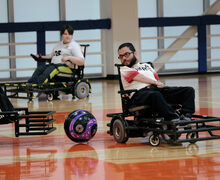Broadcast journalist Bob Dotson reflects on career at SU event
Rachel Kline | Staff Photographer
Bob Dotson, an acclaimed broadcast journalist, spoke at Newhouse on Tuesday, reflecting on his career now that he has retired.
After Bob Dotson’s first appearance on the “Today” show, his grandmother told him that he ought to learn a trade.
A question-and-answer session was held with Dotson, an acclaimed broadcast journalist, at in the Joyce Hergenhan Auditorium on Tuesday. The questions were moderated by senior broadcast and digital journalism students Cheyenne Cheathem and Hunter Saenz.
Dotson, a Class of 1969 alumnus of the S.I. Newhouse School of Public Communications, retired about a month ago after working with NBC News for the past 40 years — 35 of those years were spent hosting his series “American Story.”
The event began with a special feature “American Story” highlighting Bob Dotson’s career in storytelling in which he was referred to as the “American Storyteller.” Throughout the video, there were pictures of Dotson from childhood to adulthood with a voiceover of the difficulties he overcame, such as polio, to how he first got interested in storytelling from his grandfather.
“You think you have a tough assignment? Try boiling down 40 years into three and a half minutes,” Dotson joked.
He proceeded to thank the audience for coming and asked if somebody had said there was going to be beer afterward. This remark was welcomed by the audience with laughter.
Lorraine Branham, dean of Newhouse, responded that yes, there will be beer, but only for a select group.
Branham said getting Dotson to speak at Newhouse was one of the goals she wanted to accomplish while she was still dean — and it only took his retirement to get him there. She went on to introduce him and highlighted his numerous accomplishments, including the fact that in his career, Dotson has filed 4,000 stories for NBC and traveled about 4 million miles.
Dotson said it was terrific to be at SU and it was an anomaly that he was allowed to come to Syracuse University.
“Before we start, I just want to let you know that people my age will always tell you that the golden age of any business was three weeks before you started,” Dotson said.
Dotson went on to recount a story about his first job after graduation.
He went looking for a job at a local radio station. Dotson was told that his timing was perfect because there was an opening as the announcer of the Saint Louis Zoo. While this was not Dotson’s ideal beginning, advice from his former boss led him to Oklahoma City.
When asked what inspired him to be a storyteller, Dotson said a story his father told him about how he had met his long-lost brother on a train was what enticed him. His father wrote to his grandmother on a post card saying, “Ma we found Vance, more later…” Dotson described the post card as, “Like the first tweet.” It enticed him to learn more than the who, what, when, where and why.
Saenz, one of the moderators, then asked Dotson about what his secret techniques were for developing a story.
He said he thinks to himself, “Hey, you, see, so.”
“Hey” is how to get the viewer’s attention. “You” is thinking about how to broaden the audience and make a story resonate universally. “See” is how to make the story visually appealing. “So” is how to resonate with people.
Dotson went on to say it is also important to find the right kind of question to ask and that there is a skill in how to ask it.
He has observed that people answer questions in three parts: first they answer the question, then they explain it and the third part is where you get a good sound bite. Dotson suggests storytellers wait a bit after a person initially answers a question.
“Most journalists pop right in with another question because the answers were boring,” Dotson said.
He added that most people are uncomfortable with silence and to fill it in, they will tell you something more interesting — the third part of the answer.
Published on December 1, 2015 at 10:47 pm
Contact Stacy: [email protected] | @StacyFernandezB




